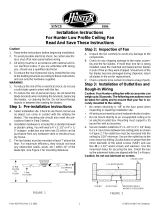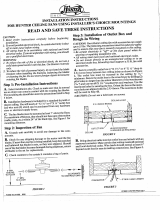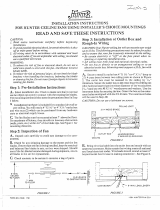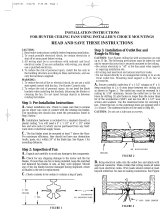Page is loading ...

FORM NO. 41068-01 8/95 - 1 - ©1995 HUNTER FAN CO.
CAUTION:
1. Read entire instructions carefully before beginning instal-
lation.
2. To avoid possible electrical shock, be certain electricity is shut
off at main panel before wiring.
3. All wiring must be in accordance with national and local elec-
trical codes. If you are unfamiliar with wiring, you should use
a qualified electrician.
WARNING:
1. To reduce the risk of fire or electrical shock, do not use a solid
state speed control with this fan. Use Hunter Controls only.
2. To reduce the risk of personal injury, do not bend the blade
brackets when installing the brackets, balancing the blades
or cleaning the fan. Do not insert foreign objects in between
rotating fan blades.
Step 1: Pre-Installation Instructions
A.
Select installation site. Check to make sure that in normal use
no object can come in contact with the rotating fan blades. The
mounting site should also meet the precautions listed in Step 3
below.
B. Installation hardware is included for a standard drywall or plas-
ter ceiling. You will need a 4" x 1-1/2" or 4" x 1/2" octagon outlet
box and wire nuts (3) which can be purchased from any hardware
store or electrical supply house.
C. The fan blades must be mounted at least 7' above the floor.
For maximum efficiency, they should not have any obstruction
(walls, posts, etc.) within 24" of the blade tips. See Figure 1
for mounting distances.
Step 2: Inspection of Fan
A.
Unpack unit carefully to avoid any damage to the components.
B. Check for any shipping damage to the motor and the fan blades.
If more than one fan is being installed, keep the matched and bal-
anced fan blades in sets, as they were shipped. Should one of the
fan blades become damaged during shipment, return all blades in
the set for replacement.
C. Check contents to be certain it contains a bag of parts.
INSTALLATION INSTRUCTIONS
FOR HUNTER LOW PROFILE CEILING FANS
READ AND SAVE THESE INSTRUCTIONS
8” MIN.
CEILING TO
FLOOR
7’ MIN.
TO FLOOR
CLEARANCE TO
OBSTRUCTIONS
24”
Step 3: Installation of Outlet Box and
Rough-In Wiring
CAUTION: Your Hunter ceiling fan with accessories can weigh
up to 35 lbs. The following precautions must be taken for safety
and to ensure that your fan is securely mounted to the ceiling.
• Be certain electricity is “off” at the fuse panel when inspecting
or repairing installation site.
• All wiring must meet local and national electrical codes.
• Do not mount directly to an unsupported ceiling or to an elec-
trical outlet box. Mounting must support a 35 lb. fan with ac-
cessories.
A. Secure a metallic outlet box 4" x 1-1/2" or 4" x 1/2" deep to 2 x 4
cross brace between two ceiling joists as shown inFigure 2. The
outlet box must be recessed in the ceiling by 1/16" minimum. Se-
cure the outlet box to the cross brace by drilling (2) pilot holes no
larger than the minor diameter of the woodscrews (5/64") and use
two #8 x 1-1/2" woodscrews and washers. Use the innermost holes
for securing the box. Orient the box so the outermost holes are aligned
with the 2 x 4 brace. The outermost holes will be used in Step 4B.
CAUTION: Do not use a lubricant on screws.
FIGURE 1
FIGURE 2
CEILING JOIST
2 x 4 WOOD BRACE
CEILING
OUTLET BOX
#8 WOODSCREW &
WASHER (2) REQUIRED
B. Bring electrical cable into the outlet box and attach with an
approved connector. Make certain that wiring meets all national
and local electrical codes. Wire leads should extend at least 6"
beyond outlet box for ease in making connections. See Figure 3.
CONNECTOR
6” MIN. LEAD LENGTH
FIGURE 3

FORM NO. 41068-01 8/95 - 2 - ©1995 HUNTER FAN CO.
Step 4: Installation of Ceiling Plate
A.
Install the (4) rubber bushings into the top of the ceiling plate
by inserting small side of the bushing into the four holes in the
ceiling plate. See Figures 4 and 4A.
FIGURE 4
FIGURE 4A
FIGURE 4B
BUSHING
CEILING PLATE
B. Thread the lead wires through the opening in the top of the
ceiling plate and through the opening in the side of the hanger
bracket. See Figure 4B.
Using the two center slots, install the ceiling plate to the 2 x 4
brace which supports the outlet box. Use (2) #10 woodscrews 3"
long and (2) flatwashers for mounting. Drill (2) pilot holes for the
mounting screws 9/64" diameter. See Figure 4B.
NOTE: When attaching ceiling plate to the outlet box support,
make certain bushings remain in place.
NOTE: Tighten the ceiling plate mounting screws only enough to
provide slight compression of the bushings. Do not over-tighten.
BUSHING
OUTLET BOX
2 x 4 BRACE
HANGER BRACKET
CEILING
PLATE
FLAT WASHER
MOUNTING
SCREWS
FIGURE 5A
FIGURE 5
Step 5: Hanging of Motor
CAUTION: Do not lift motor by wires.
A. Lift the motor and insert the plastic hanger into the opening in
the front of the hanger bracket. See Figure 5. Make sure none of
the wires are trapped between the plastic hanger and the inside of
the hanger bracket.
B. Rotate the motor and plastic hanger assembly until the lower
half of the plastic hanger fits into the square opening in the bottom
of the metal bracket. Check the assembly by trying to rotate the
motor and plastic hanger assembly. When properly installed the
upper part of the plastic hanger will sit flat inside the hanger and
the assembly will not rotate. See Figure 5A.
PLASTIC
HANGER
MOTOR
HANGER
BRACKET
HANGER BRACKET
FIT LOWER HALF
OF PLASTIC
HANGER INTO
SQUARE HOLE IN
BOTTOM OF
HANGER BRACKET
CAUTION: Make sure plastic hanger can not rotate in metal
bracket. Failure to check this could result in the motor falling.
NOTE: The green ground wire attached to the plastic hanger should
face the opening in the front of the metal hanger bracket.

FORM NO. 41068-01 8/95 - 3 - ©1995 HUNTER FAN CO.
Step 6: Final Wiring
A.
Connect electrical supply leads to the leads from the motor,
using approved connectors.
1. Connect black electrical supply lead to the black motor lead
and the black with white stripe motor lead (see note).
2. Connect the white electrical supply lead to the white mo-
tor lead.
3. Connect the ground wire to the green leads.
NOTE: If a separate wall switch will be used to control a lighting
accessory, connect the black wire with a white stripe to the wall
switch lead, following wiring instructions included with the ac-
cessory. The wall switch must be acceptable for use as a general-
use switch.
CAUTION: No bare wire or wire strands should be visible after
making connections.
B. After making the wire connections, all wires must be pushed
back up into the outlet box. The splices should be turned upward.
The wires should be spread apart with the white and the green
wires on one side of the outlet box, and the black and black/white
wires on the other side of the box.
NOTE: If the wires are not pushed up into the outlet box they
could strike the motor when it operates.
Step 7: Finish Fan Assembly
A.
Using two 8-32 by approximately 5/8" long screws, from sack
parts, thread the plastic hanger locking screws into the back of the
hanger bracket. See Figure 6. The screws should be driven all the
way into the bracket and tightened. The screws are located just
above the plastic hanger and prevent the motor from twisting when
the blades are assembled.
FIGURE 6
FIGURE 6A
Check and make sure all wiring is tucked up into the outlet box.
LOCKING
SCREWS
B. Place the fan housing over the motor assembly and fasten the
housing to the ceiling plate using the four screws provided (two
each side). See Figure 6A.
ASSEMBLY
SCREWS
FAN
HOUSING
Check and make sure the motor clears the opening in the bottom
of the housing.
Step 8: Fan Blade Assembly, Installation,
and Balancing
A.
Attach wood blades to blade brackets using three screws for
each blade. See Figure 7. If your blades have large holes you must
first insert the rubber grommets into the holes. See Figure 7A.
NOTE: Grommets are usually assembled by hand. If you use a
tool, make certain you do not damage the grommet or blade when
inserting the grommets.
Next assemble the blade to the blade bracket. Make sure all screws
are tight to prevent vibration or wobbling. A cavity in the styrofoam
packaging has been provided to nest the parts in during assembly
to assure correct alignment of parts.
Even when the screws are tight, the blades may seem to be loose.
This is normal when using grommets and will not be a problem.
FIGURE 7 FIGURE 7A
BLADE
GROMMET
B. If there are screws in the motor hub, remove them and use the
screws to attach the blades to the motor. If the motor does not have
screws, you will find them in sack parts.
Insert a mounting screw in hole in blade bracket. Use a screw-
driver to hold in place. Align blade holes with mounting holes in
hub by turning screw and readjusting blade bracket until screw
mates with threaded hole in hub. Do not tighten until both screws
have been put in blade bracket. Repeat for all blades. See Figure 8.

FIGURE 8
C. A blade balancing kit has been provided with your fan. Should
the fan wobble in operation, you may use this kit to correct the
balance per the instructions supplied with the kit.
Step 9: Light Kit Installation
A.
Install the light kit in accordance with the instructions sup-
plied with it.
PULL CHAIN
SWITCH
BREAKAWAY
CONNECTOR
PURCHASED
ACCESSORY CHAIN
(IF DESIRED)
REVERSING SWITCH
BLADE MOUNTING
SCREWS
NOTE: MAKE CERTAIN
ALL SCREWS ARE TIGHT.
INTEGRAL
LIGHT KIT
B. If your fan has a switch housing with an integral light kit as
shown in Figure 8, install bulb using guide for maximum wattage
printed on light kit and install globe, using the 3 thumb screws
provided.
Step 10: Operation of Fan
A.
Turn electrical service on at main panel.
B. Switch operates in this sequence: “High,” “Medium,” “Low,”
“Off.” Pull chain slowly to operate. Also, release the chain slowly
so as to prevent chain from flying up into blades, possibly result-
ing in damage to blades, or pull chain. The breakaway connector is
designed to separate from the chain at a predetermined force. If
this separation occurs, simply reinsert the connector. It can be re-
used again and again. See Figure 8.
C. Motor is electrically reversible. When first operating fan, de-
termine direction of air flow. If you wish to change direction, switch
fan off and allow to stop. Slide reversing switch to the opposite
position and switch fan back on. See Figure 8.
Speed Control
As an option, a wall mounted speed control switch is available
from your Hunter dealer.
®
HUNTER FAN COMPANY
2500 FRISCO AVENUE
MEMPHIS, TN 38114
©1995 HUNTER FAN CO.
FORM NO. 41068-01 8/95 - 4 -
1. Turn power on or replace fuse.
2. Check all wire connections (turn power off
while checking).
3. Push switch firmly to one side or the other.
4. Pull switch chain.
1. Power turned off or fuse blown.
2. Loose wire connections or wrong connections.
3. Motor reversing switch not engaged.
4. Pull chain switch not “on”.
TROUBLESHOOTING GUIDE
PROBLEM PROBABLE CAUSE SOLUTION
1. Nothing happens;
fan does not move.*
When switching from medium to low speed, you may notice some fan wobble. When fan speed stabilizes at low speed, wobble
will disappear.
*NOTE: If blades will not turn by hand, contact your nearest service representative.
2. Noisy operation. 1. Blade brackets loosely screwed to motor.
2. Blade screwed loosely to blade bracket.
3. Blade cracked.
4. Non-approved speed control being used.
1. Tighten screws until snug.
2. Tighten screws.
3. Replace all blades.
4. Change to approved speed control.
3. Excessive
wobbling.
1. Unbalanced blades.
2. Loose blades or blade brackets.
3. Fan not secure on hanger assembly.
1. Use balancing kit (See Step 8C).
2. Tighten all screws.
3. Turn power off, support fan very carefully.
Check hanger assembly.
/








